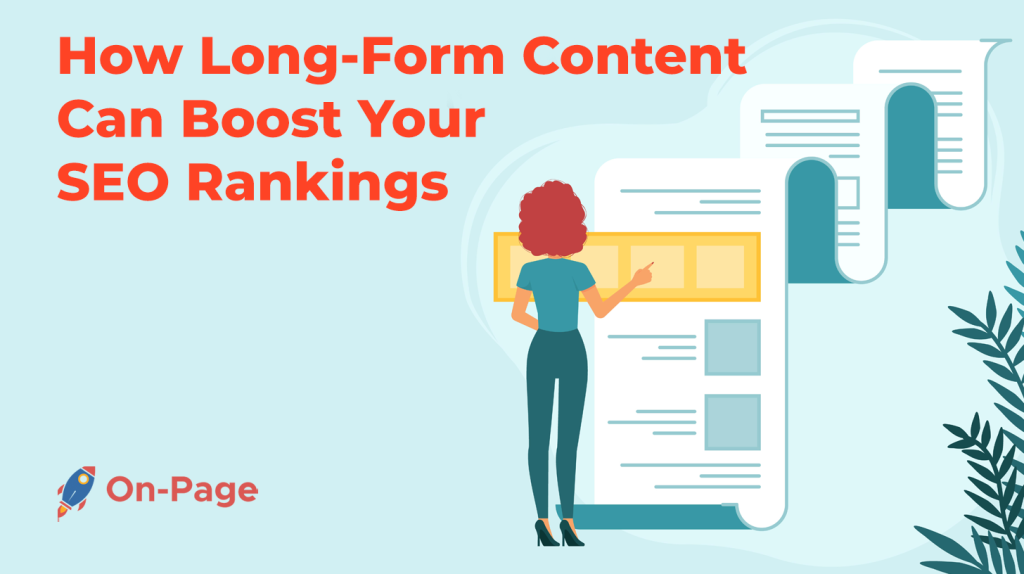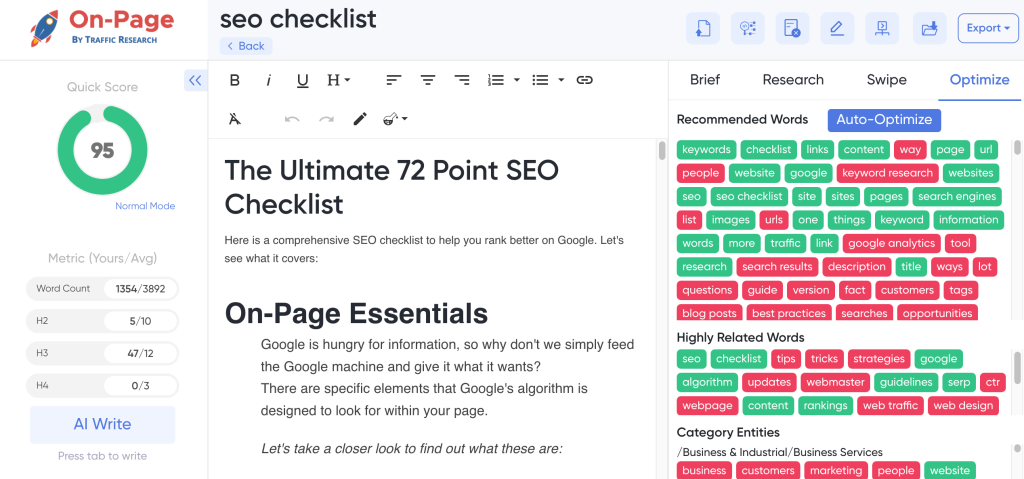
Imagine spending countless hours fine-tuning your website, only to find it buried in the digital abyss of search engine results. Frustrating, isn’t it? Now picture this: your website’s content captivates users for more extended periods and shoots your rankings up to a coveted spot on Google’s first page. It may sound like a far-fetched dream, but the reality is that long-form content can unlock this potential and supercharge your SEO rankings
. Read on to discover the magic behind longer articles, and how they can transform your website from a needle in the haystack into an attention-grabbing online treasure chest.
Long-form content can improve SEO in various ways. It tends to provide more comprehensive answers to users’ queries, leading to longer engagement time and increased content sharing. Additionally, websites with longer-form content tend to earn more backlinks, which can boost search engine rankings. Finally, Google’s algorithms favor high-quality, in-depth content, so incorporating long-form pieces into your site is an effective way to optimize your SEO.
Benefits of Long-Form Content for SEO

Long-form content has become a popular strategy for content marketing in recent years, as it provides numerous benefits for both users and search engines. In this section, we’ll explore how long-form content can boost your SEO rankings and provide tangible results for your website.
One example is how long-form content ranks higher on search engines compared to shorter pieces. A study conducted by serpIQ involving over 20,000 keywords showed that the average content length of each of the top 10 results was more than 2,000 words, making it conclusive that long-form content helps your articles rank well. Therefore, creating long-form content is a practical way to improve search rankings and visibility.
Another benefit of long-form content is increased organic traffic due to higher search rankings. As Google’s algorithm evolved over time, providing useful and relevant information to users became a top priority. This means that longer and comprehensive pieces have become more valuable to users than short ones with minimal substance. By providing rich and valuable information through long-form content, you grow trust with your readers and attract more backlinks organically as people share and link back.
Think about it this way: Would you prefer reading a comprehensive guide about a topic or multiple short posts with similar yet less detailed information? Chances are that most users would choose the former because it provides everything they need in one place rather than scouring through various posts. Therefore, long-form content increases engagement and shares by meeting readers’ needs effectively.
Some may argue that short-form content is better as readers have limited attention spans. While this may once have been true, nowadays, extensive and informative pieces are appreciated by Google’s RankBrain algorithm regarding SEO rankings. Moreover, if structured correctly, long-form pieces with clear headings and sections can break down content into smaller digestible parts, making it easier for readers to skim through information and find what they’re searching for.
Now that we’ve discussed the benefits of long-form content for SEO, let’s dive into how it helps achieve higher search rankings.
Higher Search Rankings

Creating high-quality and adequate long-form content leads to improved search rankings. If we observe the top-ranking pages on search engines like Google, we can see a trend of increased content length compared to lower-ranking pages. Here are three reasons why long-form content boosts your search engine rankings:
First, long-form content builds authority in search engines by building trust with readers. When people come across sites with valuable, informative, and extensive pieces of content – often exceeding 1k or even 2k words – they tend to recognize the site as having expertise in that area. Search engines pick up on this and increase ranking positions.
Second, evergreen long-form content does not depreciate over time or become outdated quickly. Remember that one well-researched, comprehensive piece can outperform several shorter posts with less value. Imagine reading an article from five years ago that provides practical solutions to a problem you’re currently facing. That article is evergreen and at no ongoing cost for the business owner who took the time to write it. Therefore, long-form content can generate traffic indefinitely as users continue to find it.
Thirdly, think of your website as real estate property in a popular location, while shorter items are like trailers on suburban blocks. Obtaining more space creates more opportunities to put valuable information that will result in people valuing your property more highly than others.
Increased Backlinks
One of the most significant benefits of long-form content for SEO is increased backlinks. Backlinks, also known as inbound links, are crucial for search engine optimization because they signal to search engines the relevance and authority of your content. When other websites link to your site, it shows that your content is valuable and informative, making it more likely to appear on the first page of search results. High-quality backlinks can also increase your website traffic and improve your domain authority.
Studies have consistently shown a positive correlation between long-form content and the number of backlinks it receives. A study by Moz found that articles with 3,000 or more words earned an average of 77% more backlinks than shorter articles. Another study by BuzzSumo found that longer articles (over 1,000 words) received up to four times as many social shares as shorter articles. This suggests that longer articles not only attract more backlinks but also have a higher potential for social media visibility.
For instance, imagine you run a beauty blog and create a comprehensive guide on how to do winged eyeliner. The guide includes step-by-step instructions along with detailed images and video tutorials. As a result, makeup artists, beauty bloggers, and even fashion brands might link to this post from their own websites or social media accounts as a resource for their followers. This way, you will gain high-quality backlinks naturally without having to actively outreach.
However, it is important to note that simply producing long-form content is not enough; your content must be genuinely helpful and informative to earn high-quality backlinks. This means avoiding click-bait-y headlines or shallow topics written solely for SEO purposes – they will only drive people away from your website instead of attracting them to it.
Now that we’ve explored how long-form content can earn you more backlinks, let’s delve into another crucial benefit – greater user engagement.
- According to a study by serpIQ involving over 20,000 keywords, the average content length of the top 10 search results was more than 2,000 words, indicating that long-form content helps improve search engine rankings.
- Research conducted by Moz showed a direct correlation between the length of content and the number of backlinks pointing to it, suggesting that longer content is more likely to earn valuable backlinks and thus improve SEO.
- A study by Medium found that the optimal reading time for maximum engagement with content online is around 7 minutes, which roughly translates to approximately 1,600 words. This demonstrates that long-form content has a higher likelihood of keeping readers engaged, increasing the chances of social sharing and further enhancing SEO efforts.
Greater User Engagement

Long-form content can provide a fuller and more in-depth exploration of a topic. This means that users are more likely to stay on your website for a longer period, consuming the content in detail. When users spend more time on your site, it signals to search engine algorithms that your site has valuable information which leads to better rankings and traffic for your site.
According to research by the Content Marketing Institute, 60% of marketers say long-form content is an effective way of building audience engagement. Similarly, data from BuzzSumo and Backlinko showed that longer articles receive higher levels of engagement than shorter ones. They found that posts with over 3,000 words earned an average of three times the engagement (shares, comments, likes) of those with less than 1,000 words.
For example, assume you own a blog about photography. You create an ultimate guide on landscape photography that covers everything from camera settings to post-processing techniques. A reader who is interested in this topic might find all they need in this one-page article instead of navigating through multiple blogs. They are likely to spend more time reading your article as they have found what they need, which reflects positively on your website’s SEO.
It is like focusing on having guests who stay at a hotel for extended periods instead of short stays – as frequent short stays never contribute as much revenue as a lengthy one. In the same vein, having visitors stay longer on your website indicates to Google that you provide enjoyable reading that is useful and informative and hence rank better in the Search Engine Results Page (SERP).
While creating long-form content helps with user engagement, it should not come at the cost of readability. No matter how comprehensive your content is, people are only interested in reading it if it’s easy and enjoyable to read. Therefore, when creating long-form content, break it into smaller sections with headings, use bullet points to emphasize most important ideas – so people can skim through and jump around within the article quickly.
Crafting High-Quality Long-Form Content
Long-form content takes more time and effort to produce than short-form content. It requires extensive research, planning, and editing skills to create a high-quality piece that stands out from the competition. Here are some tips for crafting long-form content that engages your readers and earns backlinks.

One way to craft quality long-form content is to use anecdotes or case studies to illustrate your points. Personal stories can provide a human element to your article, making it more relatable and memorable. For example, let’s say you’re writing an article about the benefits of meditation. Instead of just listing the benefits, you could share a personal story about how meditation helped you reduce stress in your own life.
Another key aspect of crafting high-quality long-form content is providing in-depth information on a topic. This means going beyond surface-level knowledge and offering unique insights or perspectives that readers can’t find elsewhere. By taking the time to research your topic thoroughly and provide original content, you’ll be more likely to earn backlinks from other sites.
Some writers believe that long-form content needs to be strictly structured with headlines, subheadings, bullet points, etc., while others prefer a more organic approach with free-flowing paragraphs and minimal formatting. Ultimately, the best approach is what works for your audience and subject matter. However, it’s important to avoid making the content look like one dense wall of text.
Crafting quality long-form content is like building a house brick by brick. Each section should have its purpose — adding value and insights — while contributing to an overall narrative arc. The introduction should hook readers in while the conclusion should summarize what has been discussed in depth within the article.
By keeping these tips in mind when crafting high-quality long-form content, you’ll be able to create pieces that engage your readers, earn backlinks, and improve your site’s SEO.
Providing Valuable Information
In order to maximize the impact of your long-form content, it’s essential to provide valuable information on a topic that genuinely interests your readers. Here’s how to ensure you’re offering valuable, insightful information:
One key aspect of providing valuable information is to meet user intent. It starts by researching and identifying keywords related to the topic you want to cover and then considering the searcher’s intent behind those queries. Once you know what people are searching for, it becomes easier to craft content that addresses their needs.
In addition, providing data or statistics can help illustrate the value of your content and make complex concepts easier to understand. For example, if you’re writing an article about renewable energy, sharing data points on the growing demand for solar power in different regions can help contextualize the importance of renewable energy sources.
Some writers believe that providing valuable information means including as much detail as possible, even when it might not be relevant or interesting to readers. It’s important to avoid fluff and focus on providing insights that matter. However, this doesn’t mean leaving out details altogether; it’s crucial to pay attention to accuracy as well and do a fact-checking before publishing.
Providing valuable information is like being a tour guide – instead of just showing tourists around a city, a good guide will share historical anecdotes and insider knowledge about each location. The same applies when writing quality content: Rather than just reporting on surface-level details, go deeper into the topic by adding context from history or personal stories that makes it easy to comprehend.
By focusing on providing valuable information on topics related to your site, you’ll be more likely to engage visitors and encourage them to share your content with others. With each post you publish, make sure you are offering your readers something they couldn’t find elsewhere. By doing so, you’ll establish yourself as a trusted source of high-quality long-form content.
If you need help creating high-quality content for your business or niche, be sure to check out On-Page AI Content Editor. Its powerful features like the Stealth AI Writer and Rewriter will simplify writing optimized content and take your content creation process to greater heights.

Ensuring Proper Structure
One of the keys to crafting effective long-form content is to ensure that it is well-structured. This means breaking the content up into logical sections with clear headings, using bullet points or numbered lists where appropriate, and ensuring that each paragraph has a clear purpose.
For instance, imagine you are writing an article about the benefits of yoga for mental health. To ensure proper structure, you would start by introducing the topic and providing some background information. Then, you might create subsections on different aspects of mental health that yoga can improve, such as stress reduction, anxiety management, and depression relief. Within each section, you would use bullet points or numbered lists to break down specific tips or techniques for using yoga to improve mental health.
Proper structure not only helps readers easily navigate your content but also helps search engines understand what your content is about. When search engines crawl your site, they look for cues like headings and subheadings to understand what each section is about. By structuring your content properly, you help search engines index your content more accurately and improve your chances of ranking for relevant keywords.
Some people may argue that focusing too much on structure takes away from the creativity of writing and can lead to bland content. While it’s true that over-structuring can stifle creativity, having a basic structure in place can actually be freeing for writers. It gives you a clear outline to follow and ensures that your writing stays focused and on-topic.
Optimization Strategies for Long-Form Content

Once you have created high-quality long-form content with proper structure, it’s important to optimize it for search engines so that it can rank well in search results. There are several key strategies you can use to do this.
First and foremost, make sure you are targeting the right keywords. Use keyword research tools to find out what phrases people are searching for related to your topic, and incorporate those keywords into your content in a natural way. Keep in mind that long-tail keywords – longer, more specific phrases – can be especially effective for long-form content.
In terms of length, aim for at least 2,000 words for your long-form content. This has been shown to be the minimum length needed to rank well in search results. However, don’t sacrifice quality for sheer length – it’s better to have a shorter piece of high-quality content than a longer piece that is thin on substance.
Think of optimizing your content like baking a cake. The keywords are the ingredients you need to include, just as you need flour, sugar, and eggs in a cake. But simply having the ingredients isn’t enough – you also need to prepare them properly and mix them together in the right proportions to get a delicious result. Likewise, using effective keywords is important but it’s not enough on its own – you also need to structure your content properly and provide valuable information that readers will want to engage with.
Once you have created high-quality long-form content with proper structure and optimized it for search engines, you’ll be well on your way to boosting your SEO rankings and attracting more organic traffic to your site.
Effective Keywords and Length
When it comes to optimizing your long-form content, there are really two main factors to consider: effective keywords and length.
First, let’s talk about keywords. While you don’t want to stuff your content with irrelevant or spammy keywords, you do want to make sure that you’re using the language that your target audience is searching for. One way to identify these keywords is through keyword research tools like Google AdWords Keyword Planner or Moz Keyword Explorer. These tools allow you to see what terms people are using to search for topics related to your content, and can help you identify phrases that have high search volume but low competition.

Once you’ve identified a handful of relevant keywords, you’ll want to make sure they’re included in strategic places throughout your content. This includes:
– Headline: Include your main keyword or phrase in the headline of your article.
– Subheads: Use subheads throughout your article, and include variations of your keyword in at least one subhead.
– Body text: Make sure your primary keyword appears naturally throughout the body text of your article. However, be careful not to overdo it; a good rule of thumb is to aim for 2-3 mentions per 500 words.
– Meta description: Your meta description should be a brief summary of what your article is about, including your primary keyword.
Some SEO experts argue that longer content inherently includes more opportunities for keyword optimization. For example, if an article is 5,000 words long, it may naturally include more instances of a relevant keyword than a 500-word article would. However, others argue that shorter articles can still rank well as long as they contain high-quality information and use relevant keywords strategically.
Think of it this way: Effective keyword usage is like seasoning a dish. You don’t want to overdo it and overshadow the main ingredients, but you also don’t want to leave it out entirely. When used in moderation and with intention, keywords can enhance the overall flavor of your content.
Now that we’ve talked about effective keyword usage in long-form content, let’s dive into how to leverage that content for improved user experience and sharing.
Leveraging Long-Form Content for User Experience and Sharing

One major benefit of long-form content is that it allows you to provide more comprehensive information on a particular topic. This means that your readers are more likely to find your article valuable and useful, which can lead to increased engagement and social sharing. Additionally, if your article is informative and well-structured, readers may be more likely to bookmark or share it with others who are interested in the topic at hand.
Another way to encourage user engagement with your long-form content is by incorporating visual elements like images, infographics, and videos. These elements help break up long blocks of text and make your content more visually appealing and engaging. Additionally, including alt text descriptions for images and transcripts for videos can improve accessibility for users who may have disabilities that affect their ability to see or hear.
The downside of longer content, however, is that some users may not have enough time or attention span to read through an entire article. To address this challenge, consider breaking your article up into sub-sections or making use of bullet points or numbered lists. These formatting choices make it easier for users to quickly scan your content and identify the most relevant sections.
Consider your favorite recipe book: If a recipe includes only a list of ingredients with no instructions or context, you’re likely to get frustrated and give up before actually cooking anything. However, if the recipe includes detailed instructions, helpful tips, and maybe even some photos of the finished dish, you’re more likely to try making it yourself and share your success with friends.
By effectively optimizing your long-form content for SEO and leveraging it to improve user experience and engagement, you can boost your online visibility and establish your brand as a thought leader in your industry.
Answers to Commonly Asked Questions
What qualifies as “long-form” content in terms of word count?
When we talk about long-form content, we are referring to pieces of writing that go beyond the typical 500-words SEO article. Long-form content is usually longer than 1,000 words and can go up to 10,000 words or more.
Studies have shown that long-form content performs better in search engine rankings than short-form content. Backlinko published a study in 2021 that revealed that the average Google first page result contains 1,447 words.
Moreover, Google has confirmed that it favors comprehensive and in-depth content. The search engine wants to deliver its users content that answers their query thoroughly and provides value.
Creating long-form content requires research, analysis, and organization. It enables you to delve into a topic deeply, provide unique insights and perspectives on it as well as offer valuable knowledge for readers.
In conclusion, long-form content isn’t just defined by word count alone; it’s also about providing value through extensive research and in-depth knowledge on a subject. By creating this type of content, you improve your chances of ranking high on search engines because you keep users engaged for longer periods while delivering useful information that meets their needs.
Is there a minimum word count for a piece of long-form content to positively impact SEO?
Yes, there is a minimum word count for a piece of long-form content to positively impact SEO. According to various studies, content with over 1,000 words tends to rank higher on Google’s search engine results page (SERP) than shorter pieces.
For instance, a study by Backlinko analyzed over one million Google search results and found that the average word count of top-ranking pages was 1,890 words. This suggests that longer content tends to have a more significant impact on SEO rankings.
Moreover, Google has explicitly stated that they prioritize high-quality, informative content with substantial depth and breadth. Longer articles have more opportunities for internal linking and the inclusion of relevant keywords and phrases, which can improve the page’s relevance and comprehensiveness.
However, it’s important to note that word count alone isn’t the key factor in boosting SEO rankings. The quality of the content still reigns supreme. Long-form content should provide valuable information to readers that addresses their needs accurately and uniquely.
Therefore, creating in-depth content is an excellent method for boosting your website’s SEO performance. By providing informational value through lengthy content that breaks down complex ideas into easily understandable bits makes search engines index your site thoroughly leading to better SEO rankings and greater visibility on SERPs.
What types of industries or topics benefit most from long-form content for SEO?
Great question!
When it comes to SEO rankings, long-form content can benefit almost any industry or topic. However, there are a few industries that tend to see the greatest impact from implementing long-form content strategies.
First and foremost is the health and wellness industry. According to a study by SEMrush, articles in the health and fitness niche that were over 3,000 words long received 3 times more traffic and 4 times more social media shares than shorter articles. This is likely due to the fact that people are looking for detailed, authoritative information when it comes to their health.
Another industry that can benefit greatly from long-form content is finance. Finance topics such as investing, taxes, and personal finance are often complex and require a lot of explanation. By providing detailed, comprehensive information on these topics through long-form content, finance brands can establish themselves as thought leaders in their field and attract highly engaged readers.
Finally, industries such as technology and software development also benefit from long-form content. These topics are inherently technical and complex, so providing detailed explanations can help users understand the intricacies of the subject matter. In fact, a study by Backlinko found that longer content ranks higher in Google’s search results compared to shorter content.
Overall, while every industry can benefit from long-form content for SEO, certain niches like health and wellness, finance, and technology tend to see larger benefits due to the complexities of their subject matter.
How can I structure my long-form content to optimize for SEO?
When it comes to creating long-form content that ranks well in search engines, structure is key. Here are a few tips to help you optimize your long-form content for SEO:
1. Use headings and subheadings: One of the easiest ways to make your long-form content more readable and structured is by breaking it up into sections with headers and subheaders. Not only does this make your content easier for readers to navigate, but it also helps search engines understand the hierarchy of your content.
2. Incorporate keywords strategically: While you don’t want to stuff your content with keywords, it’s important to include them strategically throughout your post. Aim to include your primary keyword in your headline, meta description, and at least a few times within the body of your content.
3. Include internal links: Including links to other relevant pages on your website can help search engines understand the context of your content and improve the overall SEO value of your site.
4. Make sure your site is mobile-friendly: As more and more people access the internet from their smartphones and tablets, having a mobile-friendly website is crucial for SEO success. In fact, 57% of all US online traffic now comes from mobile devices (source).
By incorporating these elements into your long-form content, you’ll be well on your way to boosting your SEO rankings and driving more traffic to your site.
Are there any drawbacks or challenges in using long-form content strategy for SEO purposes?
Yes, there are some challenges and potential drawbacks to using long-form content strategy for SEO purposes.
One challenge is the difficulty in creating high-quality, engaging content that remains interesting throughout a lengthy piece. This can lead to a higher bounce rate if readers become disinterested or overwhelmed with information. In fact, according to HubSpot, articles over 2,500 words have an average bounce rate of 78%, compared to articles under 1,000 words which have an average bounce rate of 56%.
Another potential drawback is that it may take longer to produce long-form content, as more research and editing may be required. This can slow down the frequency of content output and potentially affect overall traffic and engagement.
Finally, long-form content may not always perform as well in terms of social media shares or backlinks compared to shorter pieces. According to BuzzSumo, most shared articles tend to fall between the 3,000 to 10,000-word range, suggesting that extremely lengthy pieces may not resonate as well with audiences.
That being said, it is still important to incorporate long-form content into your overall SEO strategy. Despite some potential challenges, studies show that longer pieces tend to rank higher in search engine results pages (SERPs) and can generate more organic traffic over time. So while there may be some obstacles along the way, ultimately investing in long-form content can pay off in terms of improved visibility and authority in your industry.
Incorporate On-Page.ai SEO tool into your long-form content strategy to help boost your website ranking and visibility. With advanced AI-powered features like the Stealth Writer, On-Page AI makes it easy and efficient to create valuable content that will beat your competitors. Let’s get you set up today.




